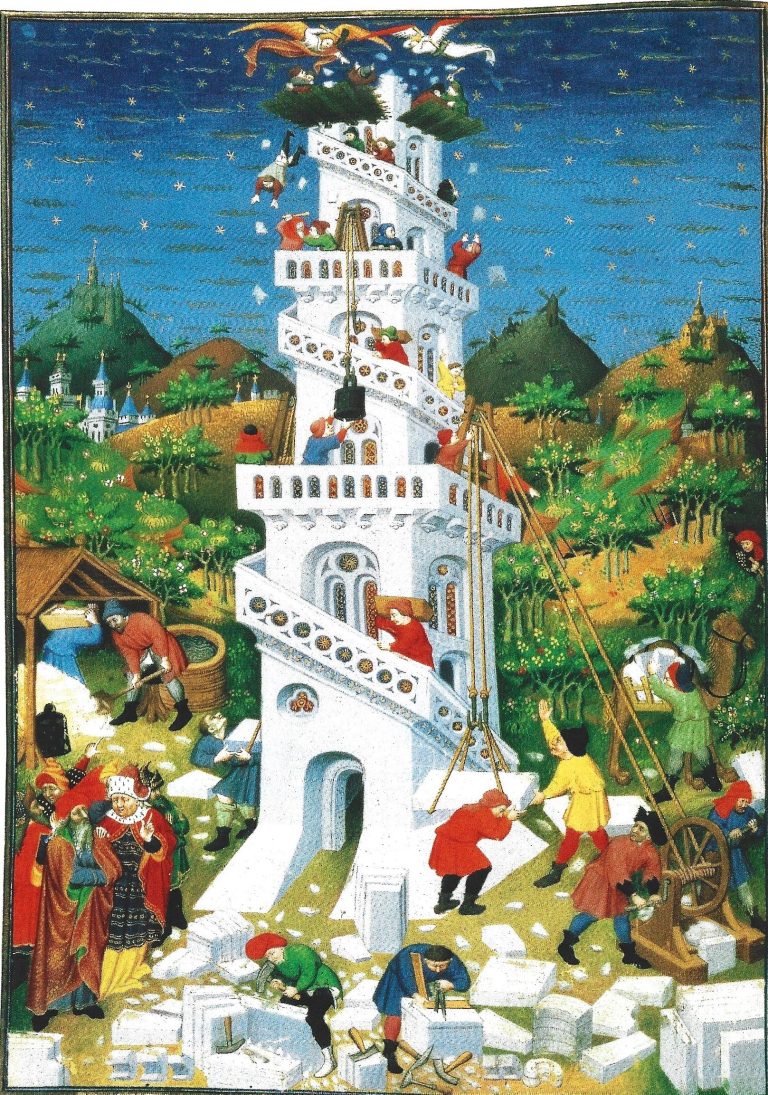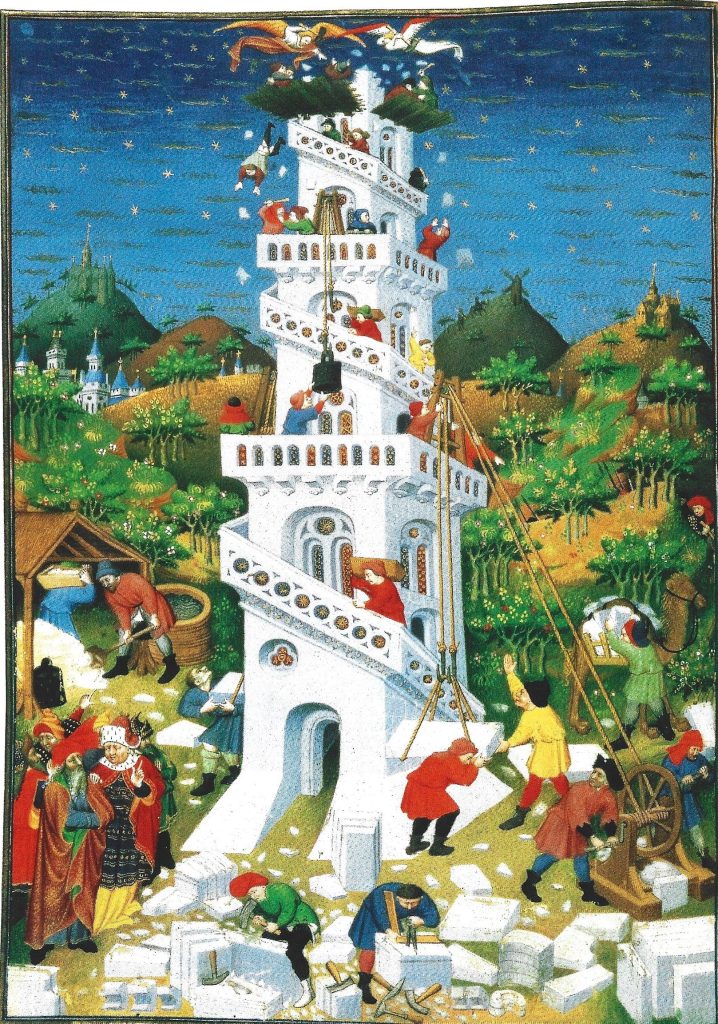

A Torre de Babel – Bedford Hours
A construção da Torre de Babel, que é descrita na Bíblia como uma obra de arrogância humana, e que resulta na confusão de línguas como castigo, é mostrada aqui num cenário familiar com trajes contemporâneos.
Vários detalhes, principalmente o camelo à direita usado como animal de carga, acrescentam um toque exótico e oriental.
Em primeiro plano, dois pedreiros trabalham com suas ferramentas. O cimento está sendo misturado sob o telhado do celeiro.
Três guindastes transportam materiais de construção para os andares superiores.
No topo da torre, há dois anjos jogando trabalhadores em luta pela borda do andaime.
Como as fotos anteriores de página inteira de Adão e Eva com seus filhos, a arca de Noé e a história pós-diluviana de Noé, a construção da torre não faz parte do conjunto usual de ilustrações contidas em um Livro de Horas.
Todas as quatro miniaturas são muito mais uma introdução.
Os exemplos que mostram da Queda do Homem necessitam da salvação descrita nas seguintes imagens do Novo Testamento.
Fonte: The Book of Hours – Park Lane New York, 1977
The Tower of Belem – Bedford Hours
The building of the Tower of Babel, which is described in the Bible as a work of human hubris, and which results in the confusion of tongues as punishment, is shown here in a familiar setting with con- temporary costumes.
Several details, particularly the camel on the right being used as a beast of burden, add an exotic, oriental note.
In the foreground, two stonemasons are at work with their tools.
Cement is being mixed beneath the barn roof. Three cranes lift building materials to the upper storeys.
At the very top of the tower, there are two angels throwing fighting workers over the edge of scaffolding.
Like the previous full-page pictures of Adam and Eve with their children, Noah’s ark and the postdiluvian story of Noah, the building of the tower is not one of the usual set of illustrations contained in a Book of Hours.
All four miniatures are much more of an introduction. The examples they show of the Fall of Man necessitate the salvation depicted in the following New Testament pictures.
Source: The Book of Hours – Park Lane New York, 1977
A Torre de Babel
Babel, em hebreu, significa “misturar, confundir, a Torre de Babel é aquela que tem a capacidade de misturar as línguas.
Onde se situava essa torre, ou a inspiração para ela, se é que houve alguma existência fisica para a edificação?
Alguns acreditam que a Torre de Babel e o zigurate da Babilonia sejam a mesma coisa.
Foi por volta do terceiro milênio antes da nossa era, quando uma onda de invasores semitas vinda do sul ocupou uma grande parte da Mesopotamia, atual Iraque, e fundou um vasto império, que a Babilônia saiu do anonimato.
Os reis logo fizeram dela uma capital influente. Seu governante mais famoso, Nabucodonosor II, venceu uma coalizão de egipcios, fenicios e judeus e conquistou Jerusalém, cujos habitantes foram deportados como prisioneiros para a Babilonia em 587 a.C.
O soberano fez de sua capital a “rainha da Ásia, um local onde muitas linguas se entre- cruzavam. E não era para menos.
Dominada por um imenso zigurate dedicado ao deus babilônico Marduk, a cidade era cercada por uma muralha de 50 quilômetros de perímetro, possuía cem portas, e era ornada, sobretudo, pelos célebres jardins suspensos, uma das Sete Maravilhas do mundo de então.
O TAMANHO DE UM ESTÁDIO
historiador grego Heródoto fez, em Histórias, uma descrição detalhada do zigurate:
“No centro (da cidade) ergue-se uma torre maciça, com a largura e o comprimento de um estádio, sobreposta por outra torre que sustenta uma terceira, e assim sucessivamente até uma oitava torre.
Uma rampa externa sobe em espiral até a última torre.
Aproximadamente no meio do caminho, há uma plataforma e bancos, para que se possa sentar e descansar.
A última torre possuiu uma grande capela, e em seu interior vê-se uma cama ricamente ornada e uma mesa de ouro.
Mas não há nenhuma estátua e nenhum mortal passa a noite ali, salvo uma única pessoa, uma mulher da cidade, aquela que deus escolheu entre todas, dizem os caldeus, que são os sacerdotes desta divindade.
E dizem ainda, mas não acredito, que o deus vem pessoalmente em seu templo e descansa nessa cama, como ocorre em Tebas, no Egito, se acreditarmos nos egípcios”.
Jules Oppert foi o primeiro a se aventurar no sítio da cidade em 1852. Mas fez apenas escavações superficiais.
Foram os alemães que, utilizando novos métodos científicos, em 1899, descobriram os principais monumentos da cidade, estabelecendo as plantas que serviriam por muito tempo como referência para os pes- quisadores posteriores.
Outras expedições foram realizadas mais tarde, pelos alemães nos anos 1960, italianos entre 1974 e 1987, e iraquianos a partir do final dos anos 1970. Há alguns anos, Saddam Hussein decidiu reconstruir a cidade para fazer dela um sítio turístico, que fica hoje a 90 quilómetros da capital Bagdá.
Novas escavações seguem sendo feitas, mas também as dificuldades com a segurança tornam a região um campo de fácil atuação para saqueadores e contrabandistas.
De toda forma, nenhuma escavação revelou até agora, com toda a segurança, vestigios materiais do zigurate Étemenanki, apesar de muitos outros terem sido facilmente identificados.
E, como seus tijolos foram retirados e reutilizados, fica ainda mais dificil dar como certo o que o senso comum repete sem constrangimento: que se trata, de fato, da Torre de Babel bíblica. (Por Malek Chebel)
Fonte: HISTÓRIA VIVA – www.historiaviva.com.br
Babel Tower
Babel, in Hebrew, means “to mix, to confuse – the Tower of Babel is one that has the ability to learn languages.
Where was this tower, or the inspiration for it, if there was any physical existence for the building?
Some believe that the Tower of Babel and the ziggurat of Babylon are the same thing.
It was around the third millennium before our era, when a wave of Semitic invaders coming from the south occupied a large part of Mesopotamia, modern-day Iraq, and founded a vast empire, that Babylon emerged from anonymity.
The kings soon made it an influential capital. Its most famous ruler, Nebuchadnezzar II, overcame a coalition of Egyptians, Phoenicians and Jews and ruled Jerusalem, whose inhabitants were deported as prisoners to Babylon in 587 BC.
The sovereign made his capital the “queen of Asia, a place where many languages intertwined. And it was no wonder.
Dominated by an immense ziggurat dedicated to the Babylonian god Marduk, the city was surrounded by a wall with a perimeter of 50 miles, possessed by doors, and was decorated, above all, by the famous hanging gardens, one of the Seven Wonders of the world at the time.
THE SIZE OF A STADIUM
The Greek historian Herodotus gave, in Histories, a detailed description of the ziggurat:
“In the center (of the city) stands a grandiose tower, the width and length of a stadium, surmounted by another tower that supports a third, and so successively up to an eighth tower.
An external ramp spirals up to the last tower approximately midway, there is a platform and benches, for one to sit and rest.
There is no statue and no mortal spends the night there, except for a single person, a woman from the city, the one whom God chose among all, say the Chaldeans, who are the priests of this hope. the god comes in person to his temple and rests on that bed, as occurs in Thebes, in Egypt, if we believe the Egyptians.”
Jules Oppert was the first to venture into the site of the small town.
The French archaeologist Titica in 1852. But he made only superficial excavations.
It was the Germans who, using new scientific methods, in 1899, reported the city’s main monuments, establishing the plans that would serve for a long time as a reference for later researchers.
Other expeditions were carried out later, by the Germans in the 1960s, the Italians between 1974 and 1987, and the Iraqis from the late 1970s onwards.
A few years ago, Saddam Hussein decided to rebuild the city to make it a tourist site, which is today 90 kilometers from the capital Baghdad.
New excavations continue to be carried out, but security difficulties also make the region an easy field for looters and smugglers.
In any case, no excavations have so far reliably revealed traces of materials from the Étemenanki ziggurat, although many others have been easily identified.
And, as its bricks were removed and reused, it becomes even more difficult to take for granted what common sense repeats without prejudice, that this is, in fact, the biblical Tower of Babel. (By Malek Chebel)
Fonte: www.historiaviva.com
Divulgado por

Consulte a Agenda do Museu a partir de 2025 e o visite quando receber sua confirmação de visita em seu email ou whatsapp.
Por se tratar de um museu particular, é necessário se cadastrar na Comunidade MuMi e customizar sua visita.
Criação e Tecnologia: Clayton Tenório @2025 MuMi – Museu Mítico